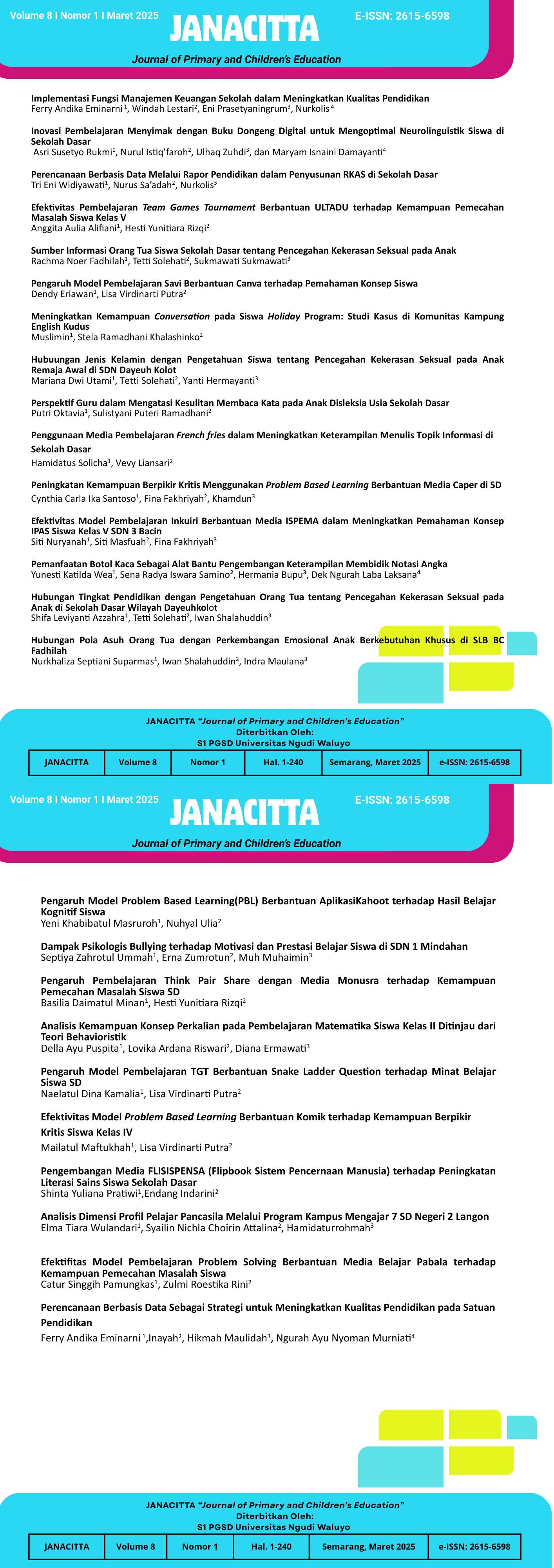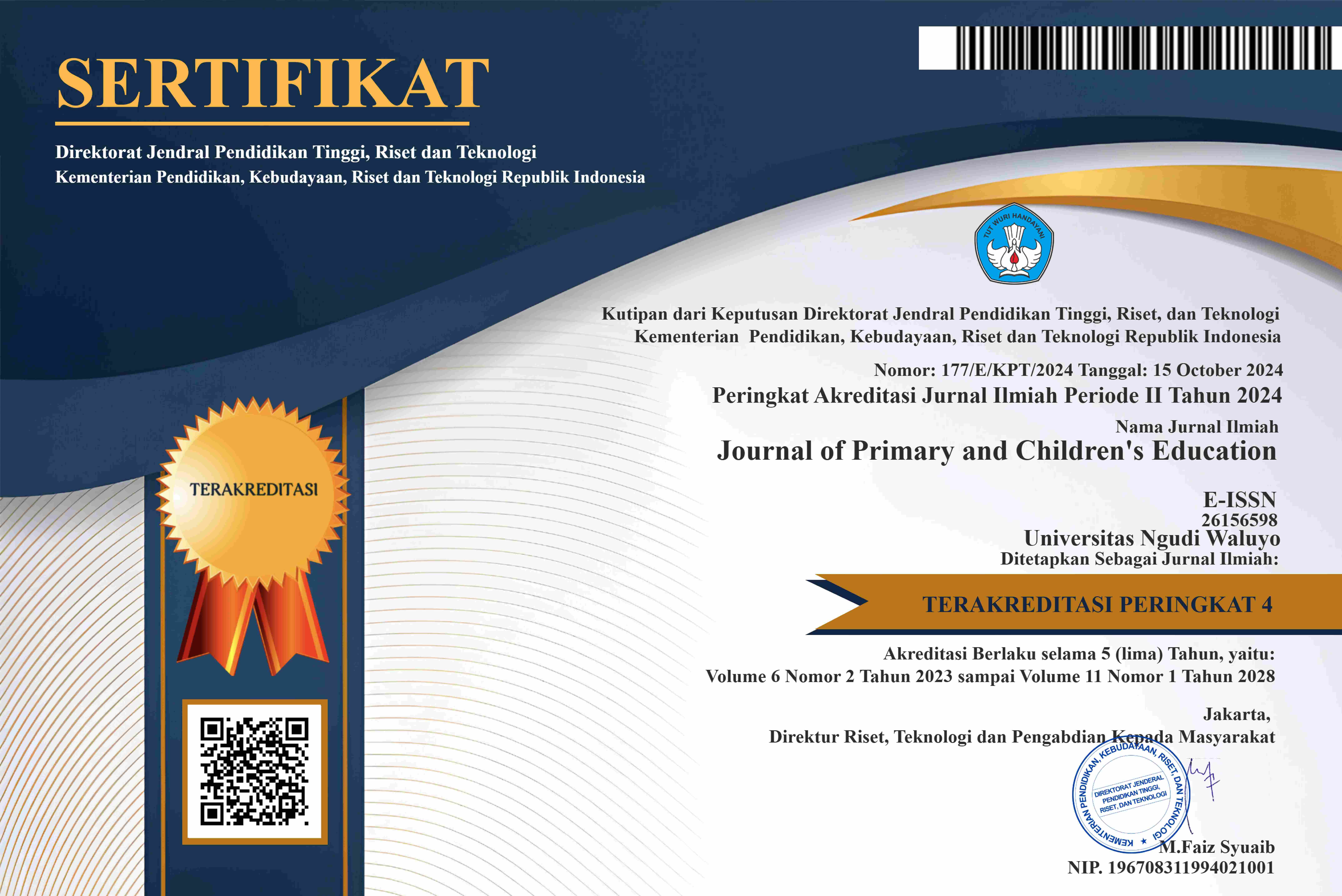Pengaruh Model Pembelajaran TGT Berbantuan Snake Ladder Question terhadap Minat Belajar Siswa SD
DOI:
https://doi.org/10.35473/janacitta.v8i1.3838Abstract
Abstract
This quantitative study aims to investigate the effect of the Team Games Tournament (TGT) learning model, facilitated by visual media and Snake Ladder Question, on the learning interest of third-grade students at SD Negeri Harjosari 01. This research employs a quantitative approach, as it seeks to determine the effect of the TGT model, assisted by Snake Ladder Question media, on the learning interest of third-grade students at SD Negeri Harjosari 01. The experimental method is used in this study, with a design similar to the pre-test and post-test control group design. The population of this study comprises 430 students, with a sample of 46 students selected using purposive sampling technique. The results of this study indicate that the Snake Ladder Question media can create an interactive and engaging learning environment. The t-test analysis yields a t-count value of 5.137, which exceeds the t-table value for df 12. Consequently, the null hypothesis (Ho) is rejected, and the alternative hypothesis (Ha) is accepted. The findings suggest that the Team Games Tournament model has a significant impact on the learning interest of third-grade students at SD Negeri Harjosari 01. Therefore, this study concludes that the Team Game Tournament model, assisted by Snake Ladder Question media, enhances the learning interest of third-grade students at SD Negeri Harjosari 01.
Abstrak
Penelitian ini merupakan jenis penelitian kuantitatif. Tujuan dari penelitian ini yaitu: Ada pengaruh dan perbedaan penggunaan model pembelajaran TGT (Team Geam Tournament) menggunakan media visual berbantuan Snake Ladder Question terhadap minat belajar siswa kelas 3 di SD Negri Harjosari 01. Model yang peneliti gunakan dalam penelitian ini adalah menggunakan metode eksperimen. Dalam rencana penelitian ini, hampir sama dengan desain kelompok kontrol pretest dan post-test di mana peneliti mendistribusikan pertanyaan-pertanyaan pre-test, menemukan situasi awal siswa, sejauh mana siswa memahami pertanyaan sebelumnya, dan post-test menyelidiki siswa setelah mempelajari model dan metode yang dikembangkan oleh peneliti dari kelas eksperimen dan kelas kontrol yang telah ditentukan. Jumlah populasi subyek 430 siswa dan jumlah sample 46 siswa diambil dengan Teknik purposive sampling. Berdasarkan hasil penelitian menunjukkan bahwa media Snake Ladder Question dapat menciptakan lingkungan belajar yang interaktif dan tidak membosankan. Hasil penelitian yang didapatkan berdasarkan analisis menggunakan hasil uji t sampel, nilai t hitung adalah 5,137, yang lebih besar dari nilai t tabel untuk df 12. Sebaliknya, ketika nilai sig(2-tailed) kurang dari 0,000, Ho ditolak dan Ha diterima. Dalam hal ini, dapat disimpulkan bahwa penggunaan model Team Games Tournament berdampak pada minat siswa kelas 3 SD Negeri Harjosari 01. Jadi dapat disimpulkan berdasarkan hasil analisis dan pembahasan mengenai model Team Game Tournament dengan bantuan media Snake Ladder Question, dapat meningkatkan minat belajar siswa kelas 3 di SD Negeri Harjosari 01.
References
Ary Yuwono, T., Puji Rahmawati, F., & Nurani Istiprijanti, T. (2022). Peningkatan Hasil Belajar Materi Siklus Air Menggunakan Model Team Games Tournament pada Siswa Kelas V Sekolah Dasar. http://jurnal.unw.ac.id/index.php/janacitta
Chafifa dan Syailin. (2024). Pengaruh Model Pembelajaran Team Game Tournament (TGT) terhadap Hasil Belajar Siswa. Jurnal Pendidikan.
Hendra, Y., & Rahayu, T. (2020). The Effectiveness of Teams Games Tournament (TGT) Learning Model and Make a Match Against Collaboration Ability on Science Content at Fifth Grade Elementary School-Meta Analysis. International Journal of Elementary Education, 4(4), 510–518. https://ejournal.undiksha.ac.id/index.php/IJEE
Larasati, T. S., Widiarto, T., Studi, P., Guru, P., & Dasar, S. (2024). Peningkatan Motivasi Belajar Menggunakan Model Teams Games Tournament Mata Pelajaran IPAS Kelas V. JANACITTA : Journal of Primary and Children’s Education, 7, 2615–6598. http://jurnal.unw.ac.id/index.php/janacitta
Putra, L. V., Mujiyono, S., & Suryani, E. (2021). Pelatihan Ultanum sebagai Media Pembelajaran Matematika di Sekolah Dasar. Jurnal Pengabdian Masyarakat (Abdira), 1(2), 87–94. https://doi.org/10.31004/abdira.v1i2.40
Setiawati, S. M. (2018). “HELPER” Jurnal Bimbingan dan Konseling FKIP UNIPA. Jurnal Bimbingan dan Konseling FKIP UNIPA, 35(1), 31–46.
Slavin, R. E. (2015). Cooperative Learning, Teori, Riset dan Praktik. Nusa Media.
Sugiyono. (2017). Metode Penelitian Kuantitatif, Kualitatif, dan R&D. Alfabeta.
Downloads
Published
How to Cite
Issue
Section
License
Copyright notice:
- Authors retain copyright and grant the journal right of first publication with the work simultaneously licensed under Creative Commons Attribution License that allows others to share the work with an acknowledgement of the work's authorship and initial publication in this journal.
- Authors are able to enter into separate, additional contractual arrangements for the non-exclusive distribution of the journal's published version of the work (e.g., post it to an institutional repository or publish it in a book), with an acknowledgement of its initial publication in this journal.
- Authors are permitted and encouraged to post their work online (e.g., in institutional repositories or on their website) prior to and during the submission process, as it can lead to productive exchanges, as well as earlier and greater citation of published work (The Effect of Open Access)







